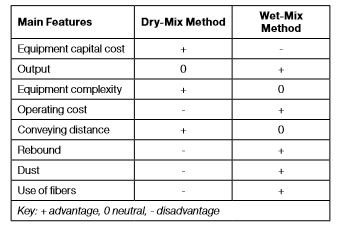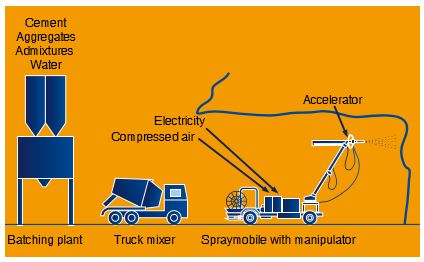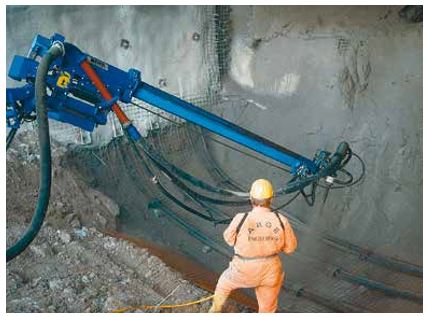Sprayed concrete as an application process
Sprayed concrete is one of several ways to cast concrete. As with traditional methods of casting, sprayed concrete also makes special demands on the characteristics of the concrete during casting. At the same time, all the normal technological demands on concrete, such as w/c ratio, amount of cement, correct consistency and curing, must be met.
Sprayed concrete also requires application by well qualified underground personnel. The application equipment for both dry-mix and wetmix sprayed concrete have improved substantially. The state-of-the-art equipment for sprayed concrete application is presented in Chapter 8 of this book.
Sprayed concrete application adequate for standard construction requirements can be achieved by either wet-mix or dry-mix methods. With the dry-mix method, the water required for hydration is added at the spraying nozzle, while with the wet-mix method the concrete mixture already contains the necessary water for hydration, i.e. water is added to the other materials in the mix at the batching plant. During application, before reaching the surface of the ground or substrate, the concrete mix passes through the spraying nozzle at high velocity (for wet-mix spraying at approx. 30 to 50 m/s), where additional components of the concrete mix, e.g. accelerators, can be added. The finished concrete mix is then sprayed under high pressure onto the surface of the ground or substrate to form a strongly compacted concrete lining. More details of both wetmix and dry-mix methods are presented in Chapter 4 of this book.
Economic and technical differences may make one method or the other more attractive for a particular application. Deciding factors may be the capital and maintenance costs of equipment, operational features, suitability of available aggregate and placement characteristics. In the following Table 1-1 the main features of the wet-mix method and the dry mix method are compared.

Table 1-1: General comparison of dry-mix method and wet-mix method
Wet-mix spraying has been most commonly used as this method gives a better working environment (high standard of health and safety), a higher and more consistent quality, and much higher production rates, with output rates as high as 20 – 30 m3 per hour, and low rebound (less than 10 %). With dry-mix spraying, much higher rebound levels (approx. 30 to 50 %) and lower performance should be expected.
The total cost of the sprayed concrete process is probably the most disputed issue during the decision process. Some contractors focus on material and equipment costs and put less emphasis on differences in labor, while others are willing to consider all imaginable influences, including savings on total construction time. Where sprayed concrete volumes are in the order of more than 50,000 m3, the difference in construction time can easily reach several months in a pure calculation of the time needed to place a certain volume of sprayed concrete onto the tunnel wall. The wet-mix process demands higher material costs, which is compensated by the multiplying effects of low rebound and high output.
The wet-mix method requires a rather simple supply system, using technology readily available in most countries, such as normal batching plants, ordinary Portland cements, truck mixers etc. The wet-mix design focuses on pumpability, low water/cement ratio and open time. The use of accelerating admixtures at the nozzle enables adaptability to given spraying conditions, e.g. position of application and water ingress. The wear costs of the whole wet-mix process are by far lower than those of dry-mix processes.

Figure 1-4: Main logistical components of the wet-mix method

Figure 1-5: Mechanized application of wet-mix sprayed concrete on the tunnel invert

